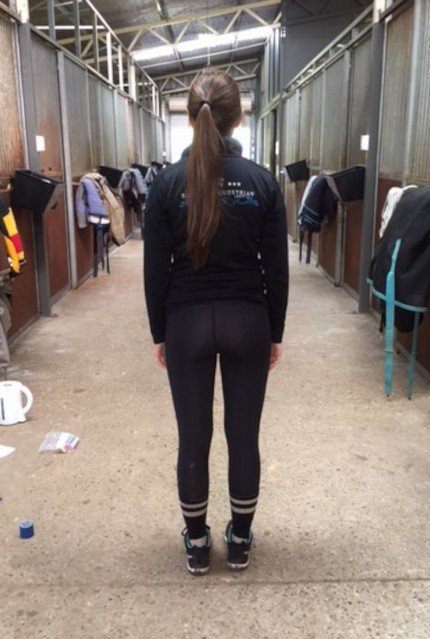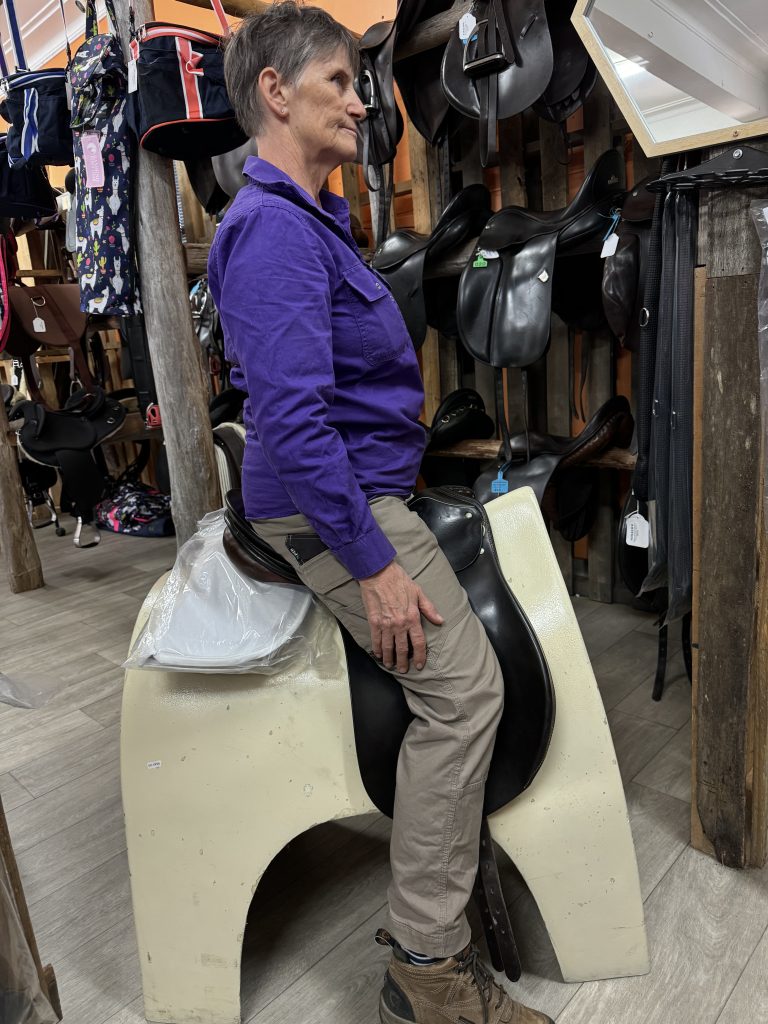Saddlefit Characteristics - Rider
Identifying your own unique saddlefit characteristics is the key to correct saddlefitting.
Saddle fit Characteristics of the Rider
I want to start out by saying that as a rider you need to be your own advocate as you may not have yet ridden in a saddle that is the correct fit for you. I rode for many years in saddles that made me bleed and when I mentioned this to my instructor or friends they all thought this was normal. During a saddlefit which always includes the analysis of the rider for their saddlefit characteristics I would ask them if they ever hit the pommel of their saddle especially during rising trot and if when they took a shower they would experience a burning sensation at the front of their pubis. They were always surprised when I asked them and all of them said yes, how did I know that? One client was actually considering labia lip reduction surgery to alleviate this problem and was astounded and extremely pleased when I informed her that surgery wasn’t necessary to achieve a comfortable ride and sourced the saddle that she was comfortable in.
Selecting the right saddle is crucial for both horse and rider, ensuring comfort, safety, and optimal performance. While much emphasis is placed on fitting the saddle to the horse, it’s equally important to consider the rider’s anatomy, particularly seat size, pelvic conformation, and gender differences. Here I delve into these aspects and address common challenges riders face during saddle selection, including budget constraints, diverse body shapes, comfort considerations, and the pitfalls of consulting with sales-driven saddle suppliers. Additionally, we’ll explore why a saddle that feels comfortable in-store may not provide the same experience when you trial it on your horse.

Saddles were designed originally by men for male riders with the only saddles thought suitable for women being side saddles. When women changed to riding astride no changes were made to saddle design until the 1990s when saddle makers began to consider the female shape and make changes to the trees. I myself have very wide set apart seat bones and feel very uncomfortable in a saddle suited for a male’s anatomy in which I feel unsupported and that I am sliding down the sides of the seat. This can result in me being very sore the next day regardless of how regularly I ride. Whereas in a saddle that supports my seat bones I feel no discomfort or muscle soreness the next day regardless of when I last rode. I didn’t think this was possible until I experienced it for myself as I thought that unless I was riding fit I would feel sore the next day having not used these muscles for a while. This lead me to discover more about the correct saddle fit for riders and how important it was that the Rider’s Saddlefit Characteristics were a vital part of the Holistic Saddle Fit.
Key Saddle Fit Characteristics of the Rider
- Postural issues
- Length of Femur
- Pelvic tilts
- Fitness
- Mindset
- Injuries and Illnesses
- Type of riding/discipline
Check out some information from UTAH State University here
Understanding Equestrian Saddle Seat Sizes
The seat size of a saddle is a primary factor in rider comfort and balance. For an English Treed saddle this is measured from the nailhead below the pommel to the centre of the cantle, standard sizes for adult riders typically range from 16½ to 18 inches. However, this measurement is not absolute; factors such as thigh length, pelvic width, and riding discipline can influence the ideal seat size. A saddle that’s too small can be restrictive, while one that’s too large may lack the necessary support, leading to instability. It’s essential to find a balance where the rider can maintain proper posture without feeling constrained.
For a Western treed saddle this is measured in 2 different ways either from the back of the fork to the front of the seat or from the front of the seat to the back of the seat (usually this will be the same measurement but not always). As a rough guide a 16inch saddle in and English tree will be the equivalent of a 14 inch saddle in a Western tree (deduct 2 inches) however this is not a hard and fast rule so each saddle needs to be measured and ridden in to ‘try it on for size’ by the rider.
The Seat width and shape comes into play here too as a saddle that is either too wide or too narrow will have the rider moving around to find a comfortable position and this will not generally be appreciated by your horse who is trying to maintain its balance with you on top. I liken this to carrying a small child on your shoulders, if the child moves one way or the other suddenly you will struggle to stay balanced and moving in a straight line.
Length of Femur
It’s not just the seat size it’s also about the proportions of the rider too. 2 riders may be the same height but one will have a longer femur than the other and this will mean that they will require different saddles for seat length and width, flap width, length and angle, stirrup bar placement, knee or thigh blocks.

Pelvic Conformation and Gender differences in Saddle Fit
Men and women have distinct pelvic structures that significantly impact saddle fit. Men typically have narrower seat bones and a higher pubic symphysis, allowing them to sit comfortably in saddles with a narrower twist and seat. In contrast, women generally possess wider seat bones and a lower, flatter pubic symphysis, necessitating a wider seat to prevent discomfort. If a woman rides in a saddle designed for a male pelvis, she may experience pressure on the pubic area and an unstable seat due to inadequate support for her wider seat bones.
These anatomical differences mean that a saddle suitable for one gender may not be appropriate for the other. Women, in particular, should seek saddles with a wider seat and a narrower twist to accommodate their pelvic structure, ensuring comfort and stability during rides. However there is also the pelvic tilt to take into account. I myself measure typically for a 42cm (16.5 inch English seat) however with my anterior pelvic tilt and pronounced pubic mound need at least a 43cm (17 inch English seat) and one without a steep rise to the pommel or I will rub against the front of these type of saddles. It is not a matter of tucking my seat underneath me as this is my individual conformation and no amount of rehabilitation will change this way that I ride, I know as I have tried and failed and endured much pain and expense until I realised this is how I was born and how I ride.
Saddle Fit Shopping Challenges
- Budget Constraints: High-quality saddles can be expensive, and while it’s tempting to opt for a more affordable option, compromising on quality can lead to discomfort and potential injury for both horse and rider. It’s advisable to set a realistic budget and explore options within that range, considering used saddles from reputable sources as a cost-effective alternative.
- Diverse Body Shapes: Riders come in various shapes and sizes, and a one-size-fits-all approach doesn’t work in saddle fitting. Factors such as thigh length, hip width, and overall body proportion play crucial roles in determining the appropriate saddle. It’s essential to try multiple saddles to find one that complements your unique physique.
- Comfort Considerations: A comfortable saddle allows the rider to maintain proper posture without strain. Discomfort can lead to poor riding habits and physical issues over time. Pay attention to pressure points, the balance of the saddle, and how it aligns with your natural riding position.
- Sales-Driven Saddle Suppliers: Some suppliers may prioritize sales over the rider’s best interests, pushing saddles that may not be the ideal fit. It’s crucial to consult with knowledgeable saddle fitters (read our article on how to talk to saddle fitters and suppliers here) who prioritize your comfort and safety over making a sale. Seek recommendations, read reviews, and don’t hesitate to ask questions to ensure you’re making an informed decision.
The In-Store vs. On-Horse Experience
A saddle that feels perfect in the store on the saddlery horse may not give you that same feel when it’s on your horse. For a start does the shape of the saddle horse look like your horse’s shape as saddlery horses tend to have a high wither and be much narrower than most real horses. Also the saddle will not be fitted to the saddlery horse’s shape as that horse will not complain or be discomforted by an ill-fitting saddle.
I used to take my clients who experienced pain when riding to saddleries and trade shows to sit in different saddles to get a feel if the saddle felt comfortable, however I soon realised that this was not a good way to gauge the true feel unless I could set up the saddlery horse to be the same width as their horse and find a saddle to match that shape. Also the dynamics change due to the horse’s movement, back shape, and the interaction between horse and rider.
It’s crucial to test ride the saddle on your horse before finalising the purchase to ensure that it is the correct fit for both of you. This is often the missing piece in the saddle fit process as the correct saddle may not be available and either need to be ordered or custom made. While many reputable saddle fitters and suppliers offer trial periods, allowing you to assess the saddle’s performance in real-world conditions they may not be willing to take back a saddle that has been a special order or custom made. It is vital that you only proceed with the order as long as the saddle can be returned and a full refund paid providing the saddle is returned in a saleable as new condition. This ensures that both you and your horse are comfortable and that the saddle supports effective communication and performance through correct saddlefit and you are not landed with a saddle that you have paid for that does not fit.
Conclusion
Selecting the right saddle is a nuanced process that requires careful consideration of both horse and rider. Have a look at the online couse “Identifying the Horses Saddlefit Area” Here. Understanding the intricacies of seat sizes, pelvic conformation, and gender differences is essential in making an informed choice. By acknowledging and addressing common challenges such as budget constraints, diverse body shapes, and the importance of consulting with reputable professionals, riders can find a saddle that enhances comfort, performance, and the overall riding experience. Remember, a saddle is a significant investment in your equestrian journey; taking the time to choose the right one will pay dividends in the long run.
